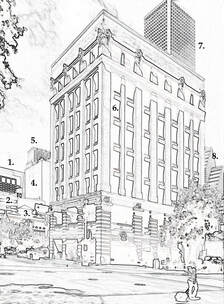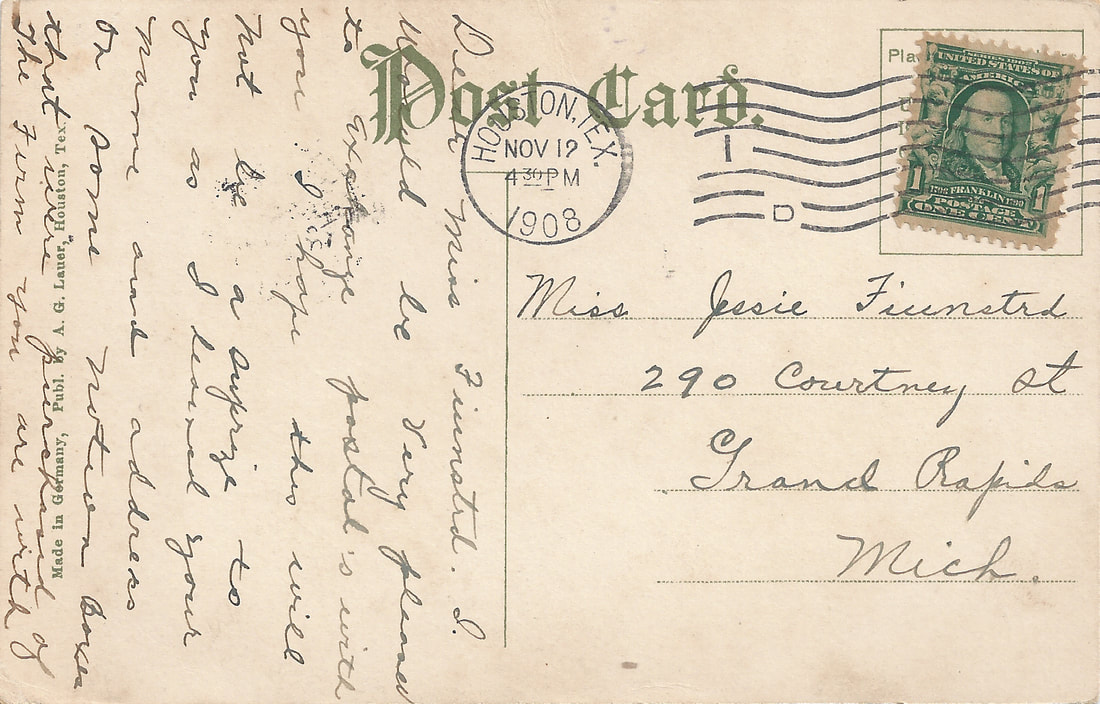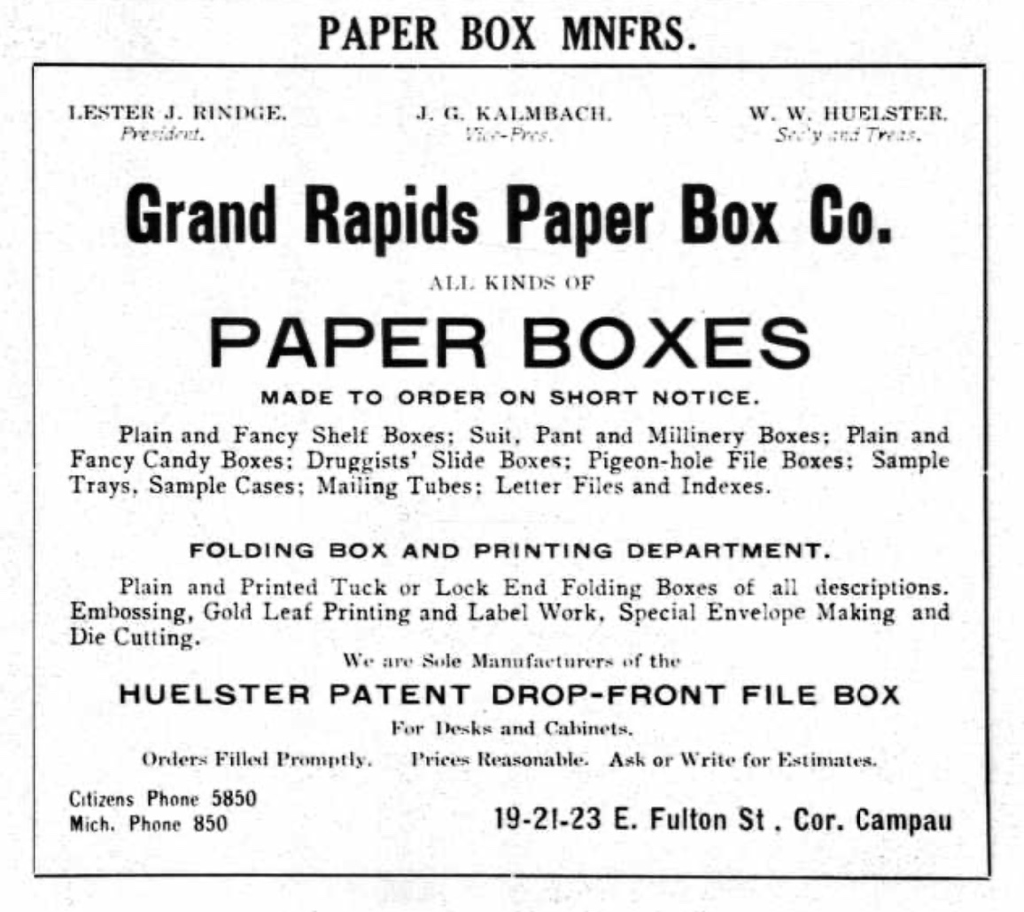Paul Building
|
Postmarked: 12 November 1908; Houston, Tex. “D”
Stamp: 1c Blue Green Ben Franklin #300 To: Miss Jessie Fiunstrd 290 Courtney St Grand Rapids Mich. Message: Dear Miss Fiunstrd. I would be very pleased to exchange postal's with you. I hope this will not be a suprize to you as I learned your name and address on some notion boxes that were purchased of The Firm you are with. [continued on front] I am cashier with Levy Bros. and wish you to answer this real soon we are now having our fall carnival and there are very many people from all over the state. P.S. Answer this soon - Sincerely Jules Wolf Levy Bros Houston Texas The postcard was directed to “Miss Jessie Fiunstrd,” and Jules indicated he had learned her name and address from some notion boxes purchased from the firm she worked for. She was actually Jetske “Jessie” Van der Wal, 18 year old daughter of Atje “Agnes” Boomsma and Sierk Van der Wal, who had immigrated on the ship Leersdam from Het Bildt, Friesland on in the north coast of the Netherlands on 6 April 1889. Children on board were 3 year old “J” (John, b. 1885), and 6 year old “W” (who may have died before the 1900 census in Grand Rapids). Sierk and Atje spent some time in Paterson, NJ where Jessie was born, before moving to Grand Rapids, MI by 1894. Sierk died in Grand Rapids shortly after 1893, and Atje married Ale “Albert” Tuinstra about 1898, who was also from the Netherlands. Jessie must have used her mother’s name at the firm she worked for, almost surely Grand Rapids Paper Box Co. which dealt in notion boxes. Jessie’s occupation on the 1910 census was “machine hand - paper box factory, and the largest such firm in Grand Rapids (whose population in 1910 - 112,571 - was about twice that of Houston - 78,800) was the Grand Rapids Paper Box Company. It seems likely that Jessie ignored the postcard from a stranger in Houston.
Jessie would remain in Grand Rapids the rest of her life, and married Fred Koerts in 1923, who died at 43 years of age in 1930. They apparently had no children; she married in 1936 Leonard Zweedyk, also Dutch, a widower. Leonard died in 1965 and was buried in Washington Park Memorial Gardens in Grand Rapids beside his first wife Bessie (1882-1934) and their children. Jessie died in 1982 and was buried in Greenwood Cemetery in Grand Rapids. |
Who was this young man to send such a yearning and vulnerable postcard to a woman whose address he found at work? Jules Hohenthal Wolf was nineteen at the time, the rather brash youngest son of Nathan and Fannie Levy Wolf, who had originally come from New Orleans. They lived at 1417 Texas near Austin, but after Nathan died in 1910 the family moved to 2701 Main at Dennis. Helping the widow were the five grown brothers, one married living there with his wife, as well as two black servants who lived at the rear of the property. The new neighborhood was a prosperous one in 1910, nearly every house was headed by a professional, and most had black servants living in the back, a hallmark of the middle class Southern family of the time [See also Westmoreland]. Jules was a clerk at the Boston Shoe Store (Levy & Wolf) on the corner of Main and Preston, a store owned by his eldest brother Charles S. Wolf and Uncle Jonas Levy, his mother’s younger brother. The Levy’s were apparently unrelated to Abraham Morris Levy and his brothers, Haskell and Hyman, proprietors of Levy Bros. Dry Goods store on the same block, perhaps the largest such establishment at the time in the entire South. Jules directs the postcard respondent to reply to the dry goods store, so perhaps he had work there as well.
Jules lived in the large house on Main at Dennis through most of his twenties, and when he registered for the draft in 1917, he indicated that he was "Tall" and of "Medium' build, with gray eyes and brown hair. He claimed an exemption on account of "eyesight," and rather cheekily entered “American” as his race. He was Jewish, and may have been subject to some prejudice, even in relatively broad-minded Houston whose large mercantile community included Jewish families: Battlestein, Farb, Finger, Kiam, Sakowicz, Taub, Weingarten, Westheimer, and Levy families. Within three years, perhaps inspired by his brother Maurice, proprietor of a theater, he moved to Denver and worked in film distribution for Goldwyn Corp., and later the International Educational Film Exchange. About 1921 he married Frieda Rosenthal, daughter of Jacob Rosenthal from Romania and Annie from Germany. Freda was born in California, but moved to Salem, then Portland, Oregon where she grew up. Jules and Freda had two children, Joseph N. (1923), and Regina I. (1924), while in Denver. In Los Angeles, where the family moved after Regina was born, Jules was manager of a cinema, and they lived at 829 S. Masselin, near Wilshire Boulevard. Freda died in 1960, and he married 2) Rose Cahn Ellis in Nevada 30 March 1961. Jules died 28 May 1972 in Los Angeles, and was buried beside Frieda at Mt. Sinai Memorial Park in Los Angeles. His mother, Fanny Levy Wolf died in 1928 and is buried at Beth Israel Cemetery near her husband, Nathan. |
As I stood on the curb in front of the courthouse to take my photograph of the Paul Building (Republic Building on the marker near the entrance), I paused to look down at the message obscuring the face of the postcard. Although some collectors of postcards prefer unblemished images, my taste is to prefer cards with interesting messages, even when the writing obscures parts of the image. Fortunately, Jules gave his last name, making it much more likely to find him on the census. There is always a bit of luck involved in finding a particular person on the census, but with Jules I got very lucky indeed.
As details emerged about Jules Wolf, I became increasingly intrigued at how his life intersected with mine. His childhood home at 2703 Main is now the location of the parking lot for Art Supply on Main, a store I frequent for art supplies and monthly meetings of Print Matters, a group of printmakers I am a member of. After my discovery of the history of the site, I find that when I chain my bike up at the entrance, I half expect to hear the the sound of boys playing: Did Jules and his brothers bring a baseball out into the street in the evenings for a quick game of catch?
Jules' mother is buried at Beth Israel Cemetery Cemetery at 1207 West Dallas. I am fascinated by cemeteries and their link to the history of a place, so whenever I have the time, I stop at cemeteries and scan the stones for tidbits of the lives behind the monuments. I often run past Beth Israel on my morning run, and when the gates are open I will catch my breath amid the monuments. Abe Levy's crypt so prominently placed in front of the mausoleum has captivated me from my first visit. Fanny's tombstone is at the west side of the cemetery, where she is buried next to her husband Nathan, son Charlie and daughter-in-law Bertie.
Even when Jules left Texas, he blazed a trail I was destined to cross. In 1930 he lived at 829 S. Masselin Street, Los Angeles in a part of the city called The Miracle Mile. The Los Angeles County Museum of Art is there, and I have been many times. If I had a time machine, I might have spotted Jules or Freida there shopping or just enjoying Boulevard life. When they fled the glitter of Wilshire Boulevard for the Pasadena area, they located within a couple of miles of the Huntington Gardens, another of my California haunts.
History seems an inert presence for most of us, dead lives don't seem to touch us in any intimate way. But if we listen, we might hear them calling out to us.
As details emerged about Jules Wolf, I became increasingly intrigued at how his life intersected with mine. His childhood home at 2703 Main is now the location of the parking lot for Art Supply on Main, a store I frequent for art supplies and monthly meetings of Print Matters, a group of printmakers I am a member of. After my discovery of the history of the site, I find that when I chain my bike up at the entrance, I half expect to hear the the sound of boys playing: Did Jules and his brothers bring a baseball out into the street in the evenings for a quick game of catch?
Jules' mother is buried at Beth Israel Cemetery Cemetery at 1207 West Dallas. I am fascinated by cemeteries and their link to the history of a place, so whenever I have the time, I stop at cemeteries and scan the stones for tidbits of the lives behind the monuments. I often run past Beth Israel on my morning run, and when the gates are open I will catch my breath amid the monuments. Abe Levy's crypt so prominently placed in front of the mausoleum has captivated me from my first visit. Fanny's tombstone is at the west side of the cemetery, where she is buried next to her husband Nathan, son Charlie and daughter-in-law Bertie.
Even when Jules left Texas, he blazed a trail I was destined to cross. In 1930 he lived at 829 S. Masselin Street, Los Angeles in a part of the city called The Miracle Mile. The Los Angeles County Museum of Art is there, and I have been many times. If I had a time machine, I might have spotted Jules or Freida there shopping or just enjoying Boulevard life. When they fled the glitter of Wilshire Boulevard for the Pasadena area, they located within a couple of miles of the Huntington Gardens, another of my California haunts.
History seems an inert presence for most of us, dead lives don't seem to touch us in any intimate way. But if we listen, we might hear them calling out to us.




